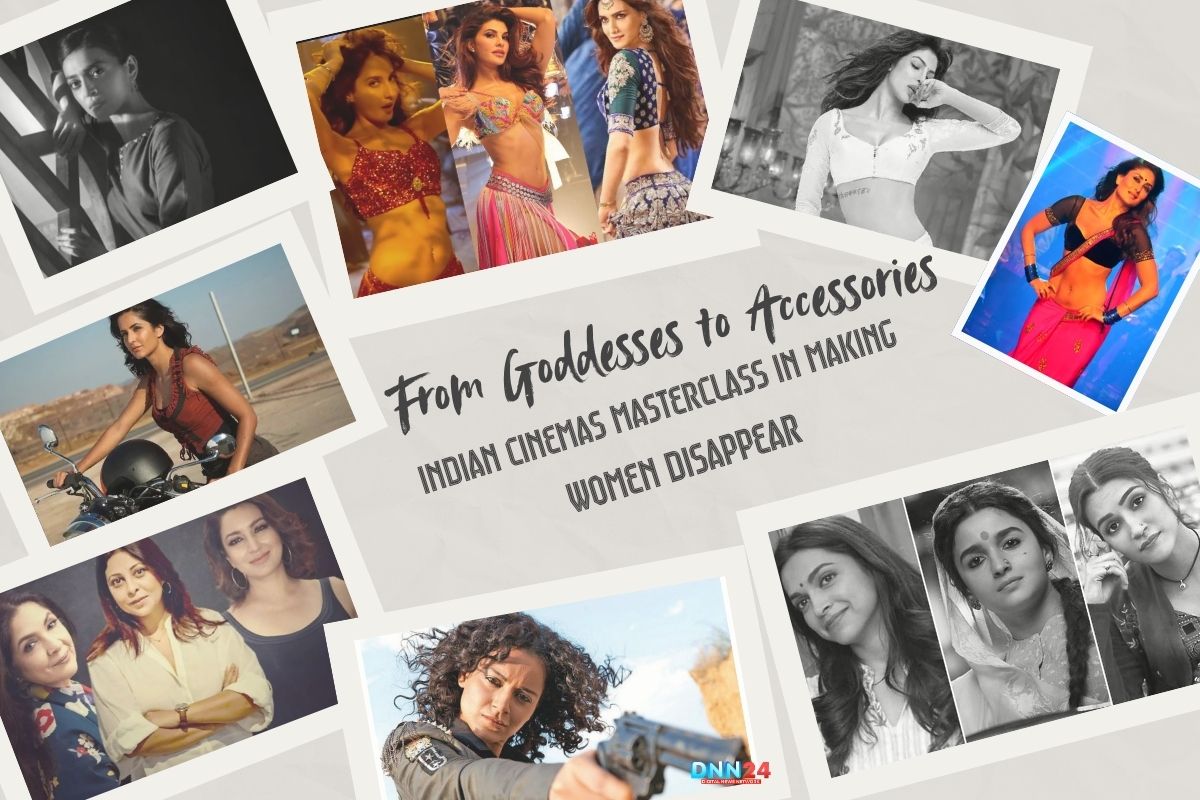Let’s not beat around the bush: Indian cinema has always had a love affair with its heroines—but only as long as they stay inside the lines. From the ever-sacrificing maa to the glamorous Accessories, our films have worshipped women as goddesses, only to shrink them down to shiny accessories when the real story begins. We’ve clapped as the hero fights, whistled as two friends unite, and felt sad over the mother’s selflessness. Have we ever stopped to consider where she is actually? When she doesn’t support the hero, who is she outside of those roles? I can’t recall seeing a Bollywood heroine with a goal except to find a man.
Indian Cinema: Props, Plot Devices, and Pretty Faces
Take a stroll through the Bollywood Hall of Fame, and you’ll find women everywhere—except at the center of their own stories. However, her character in Zindagi Na Milegi Dobara looks like a diving instructor. Her only aim is to bring a change to Hrithik’s character. At the beginning of ‘Sacred Games,’ Radhika Apte’s character is interesting and sets up a promising theatre for a woman’s adventure.
Then, her story is cut off when it is convenient to further the plot centered around male action. Women are introduced as love interests, mothers, or the obligatory item number—never as people with their ambitions, flaws, or agency. It’s as if the scriptwriters got a memo: “Women must be seen, not heard—and preferably only in slow motion.”
Indian Cinema’s The Item Number: Costume Party or Character Assassination?
Let’s discuss item number, the go-to costume party for Bollywood movies. Here, women are not just dressed up—they are dressed down, literally and figuratively. The shots linger, the music swells, and our main character is now little more than a doll being used. It’s a party where only women are forced to dress up, dance, and disappear the moment the hero reclaims the screen. The item number is not just a song—it’s a reminder that, in Indian cinema, women are costumes, not characters. Imagine painting a picture and erasing half the colors. That’s what happens when women are reduced to eye candy: the canvas loses its vibrancy, and the story loses its soul.
Indian Cinema’s Old Tropes, New Wrappers: Have Things Really Changed?
Sure, we’ve seen some progress. Films like ‘Queen’ and ‘Piku’ gave us women with agency, dreams, and flaws. Streaming platforms have opened the doors a crack wider, letting in stories like ‘Delhi Crime’ and ‘Four More Shots Please!’ that put women front and center. Still, for every positive development, we are quickly brought back by ten forgettable films.
The numbers don’t lie: only 12% of heads of departments in Indian cinema and TV are women, and just 10% of senior roles are held by women. Even in 2025, women are more likely to be found in the kitchen on screen than in the director’s chair. The Bechdel Test—a simple check for whether women talk to each other about something other than a man—is still failing in nearly half of Indian films and series.
Indian Cinema’s Beloved Films, Forgotten Women: A Closer Look
Let’s look at some of the shows that got the biggest cheers. In this film, the three leading male actors experience discovery, adventure, and brotherhood. The women? One helps the main character heal emotionally; the other is a simple phone call. ‘Sacred Games’ shows that, for men, a variety of emotions, conflicting actions, and reform are allowed. Female characters are often removed from the story along with their stories. Many big films, for example, ‘Kabir Singh,’ give the heroine a secondary role and drown out her voice with the hero’s anger. The message is clear: women can be anything, as long as they don’t overshadow the man.
The Invisible Workforce: Where Are the Women Behind the Scenes?
The problem goes deeper than meets the eye. The numbers get even worse when we look at what happens behind the camera. Only 10% of senior creative roles—directors, writers, editors—are held by women. Across the eight languages I analyzed, all 56 theatrical films were directed or edited by men only. When women do get a seat at the table, the difference is visible: more films pass the Bechdel Test, and women get more screen time. Streaming platforms are doing slightly better, but the industry as a whole is still stuck in the past, clinging to the idea that men make the rules and women follow them.
Indian Cinema’s Is Streaming the Real Saviour?
Streaming platforms have brought a breath of fresh air with more women-led stories and diverse characters. Shows like ‘Delhi Crime’ and ‘Made in Heaven’ have given us complex, flawed, and powerful women. But we shouldn’t get too excited until we’re sure. For every ‘Delhi Crime,’ there are dozens of web series that still use women as props, plot twists, or background decoration. There is real progress, but it’s happening slowly—and usually, this progress is just found online, as old themes keep appearing in big movies.
Also Read: Untold Stories of Shashi Kapoor’s Cinematic Journey
Why Are Women Still Written as Costumes, Not Characters?
Here’s the uncomfortable truth: Indian cinema is a mirror, and what we see on screen reflects what we tolerate from it. This industry is largely controlled, written, and aimed at men. Scripts are written from the male gaze, stories are told through the hero’s eyes, and women are slotted into roles that serve the man’s journey. When women do get a story, it’s often about their relationship with a man: the dutiful wife, the sacrificing mother, the unattainable love interest. Rarely do we see women as individuals with dreams, flaws, and agency of their own.
Asking the Hard Questions: Who Gets to Tell Women’s Stories?
Can you recollect any Bollywood actress with a goal that wasn’t about a man? Why do female characters commonly get excluded, marginalized, or erased from stories? Who has the power to pick what stories are shared, and who gets represented? The findings are challenging to accept, but they must be dealt with. Until more women are allowed to write, direct, and produce films, the stories will stay the same. As long as people are fine seeing the same old ways, the industry will keep doing the same things, just in different forms.
A Ray of Hope: The Slow Rise of Real Women on Screen
Things aren’t as bad as they seem. Films like ‘Raazi,’ ‘Mardaani,’ and ‘Gunjan Saxena: The Kargil Girl have shown that audiences are hungry for stories about real women—flawed, fierce, and unforgettable. Along with showing us powerful female leads, these films gave us characters with significant depth and clear ambition. The rise of women in leadership roles in creative industries is a sign that change is possible, even if it’s slow. People under 25 want to see stories that are diverse and genuine, and filmmakers are paying attention.
How We Can Progress from Stereotypes to Strength
The path from gods and goddesses to accessories is still going on, and we hope it leads to full characters. Indian cinema has made some progress, but the road ahead is long. The industry needs more women in decision-making roles, more stories that pass the Bechdel Test, and more films that let women be the heroes of their own lives. Audiences, too, have a role to play: by demanding better stories, supporting women-led films, and calling out lazy stereotypes, we can help rewrite the script.
The Last Time Around: Why How We Are Seen Matters
When women are written as costumes, not characters, we lose not just their stories—but our chance to see the world in full color. Indian cinema is a powerful mirror, shaping how we see ourselves and each other. When we have little or no representation of half the population, what does that reveal about who we are? It’s time to demand better—not just for women but for everyone who believes that stories should reflect the full spectrum of human experience.
Better films to watch, better policies, and better conduct from leaders
The point I’m making here is, ask yourself the next time you watch a film: where is she in the story? What is she like, apart from what she does for the man? But if you disagree, ask for a better reason. Because when women are finally allowed to be more than just costumes, Indian cinema—and all of us—will finally get to see the world in all its colors.
Also Read: Kishore Kumar: Singing, Smiling, and the Sound of Stardom
You can connect with DNN24 on Facebook, Twitter, and Instagram and subscribe to our YouTube channel.

